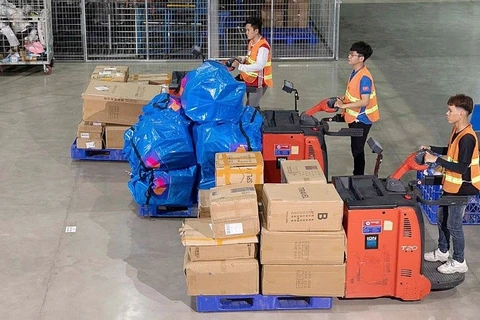 The rapid development of e-commerce has provided significant support to the retail sector. (Photo: VietnamPlus)
The rapid development of e-commerce has provided significant support to the retail sector. (Photo: VietnamPlus) Hanoi (VNA) - Shopping for goods on e-commerce platforms and social networks, such as Zalo and Facebook, is no longer strange to consumers. Fast and convenient transactions thanks to the application of technology have brought about significant changes in the retail industry. This is especially the case with the gradual transition of physical stores being replaced by buying and selling through online marketplaces.
Before 2020, Tran Phi Long, owner of a retail chain of consumer products in Hanoi, had four stores concentrated in densely populated areas. Since shifting to online business and opening more stores on e-commerce platforms, the sales of his stores increased sharply due easier access and resulted in cost reductions.
“The rental expenses are cut, and I just need to focus on promotions and taking care of customers, thus, everything is also more intensive and faster," said Long.
The COVID-19 pandemic has become a powerful catalyst for changing consumer shopping habits. Instead of shopping directly in stores or supermarkets, people have become accustomed to shopping on e-commerce platforms, websites, and social networks without having to spend much effort.
Vu Thi Hau, former Chairwoman of the Vietnam Retail Association, said that during the pandemic, e-commerce sales developed vigorously. Retailers quickly adapted to better serve consumers and they invested a lot in technology and human resources to meet demand. Manufacturers also took advantage of their own websites, e-commerce sites and social network platforms to boost consumption, she said. This is also the trend of the retail industry in the future, especially for agricultural products, she opined.
 With just a "touch" on their smartphones, consumers can purchase items from anywhere. (Photo: VietnamPlus)
With just a "touch" on their smartphones, consumers can purchase items from anywhere. (Photo: VietnamPlus) Enhancing connection to supply chain
In recent years, Vietnam's e-commerce has witnessed rapid and robust growth. Currently, over 73% of Vietnam's population uses the internet, with 78% engaging in online shopping.
According to the Vietnam E-commerce Report, the scale of the retail e-commerce market in Vietnam reached 16.4 billion USD in 2022, accounting for 7.5% of the total retail revenue of goods and consumer services nationwide. The estimated average online shopping value per person per year is 288 USD.
Cross-border cooperation programmes with major international e-commerce platforms like Amazon and Alibaba have been deployed, supporting small and medium-sized enterprises (SMEs) to boost exports. Through these programmes, Vietnam's key products, namely agricultural products, processed foods, handicrafts, and consumer industrial products, can be exported directly from manufacturing businesses to markets of many countries around the world via e-commerce.
Nguyen Thi Mai Anh, Deputy Director of the Hanoi Centre for Investment, Trade and Tourism Promotion, said that cross-border e-commerce not only creates opportunities for businesses to increase sales revenue but also seeks flexible business models, cost reduction, and optimise resource to access the global supply chain.
According to Dang Thanh Tung, Head of Market Development Division under Centre for Information and Digital Technology, Vietnam’s E- Commerce and Digital Economy Agency at the Ministry of Industry and Trade, is building and will implement a regional e-commerce connection programme to expand online Vietnamese stores. The programme focuses on developing a network of manufacturers, distributors, and other related parties in the agricultural, local and industrial goods, he continued.
This network helps enhance market access capabilities, meet consumer needs, and promote regional cooperation. It will foster collaboration between agricultural production regions to consolidate strength and improve competitiveness in the market.
The building of a network via e-commerce enables local producers to access the market more effectively and meet consumption needs. Thanks to the partner network, local agricultural products and specialties can be promoted and reached to a large number of consumers through online channels./.
























